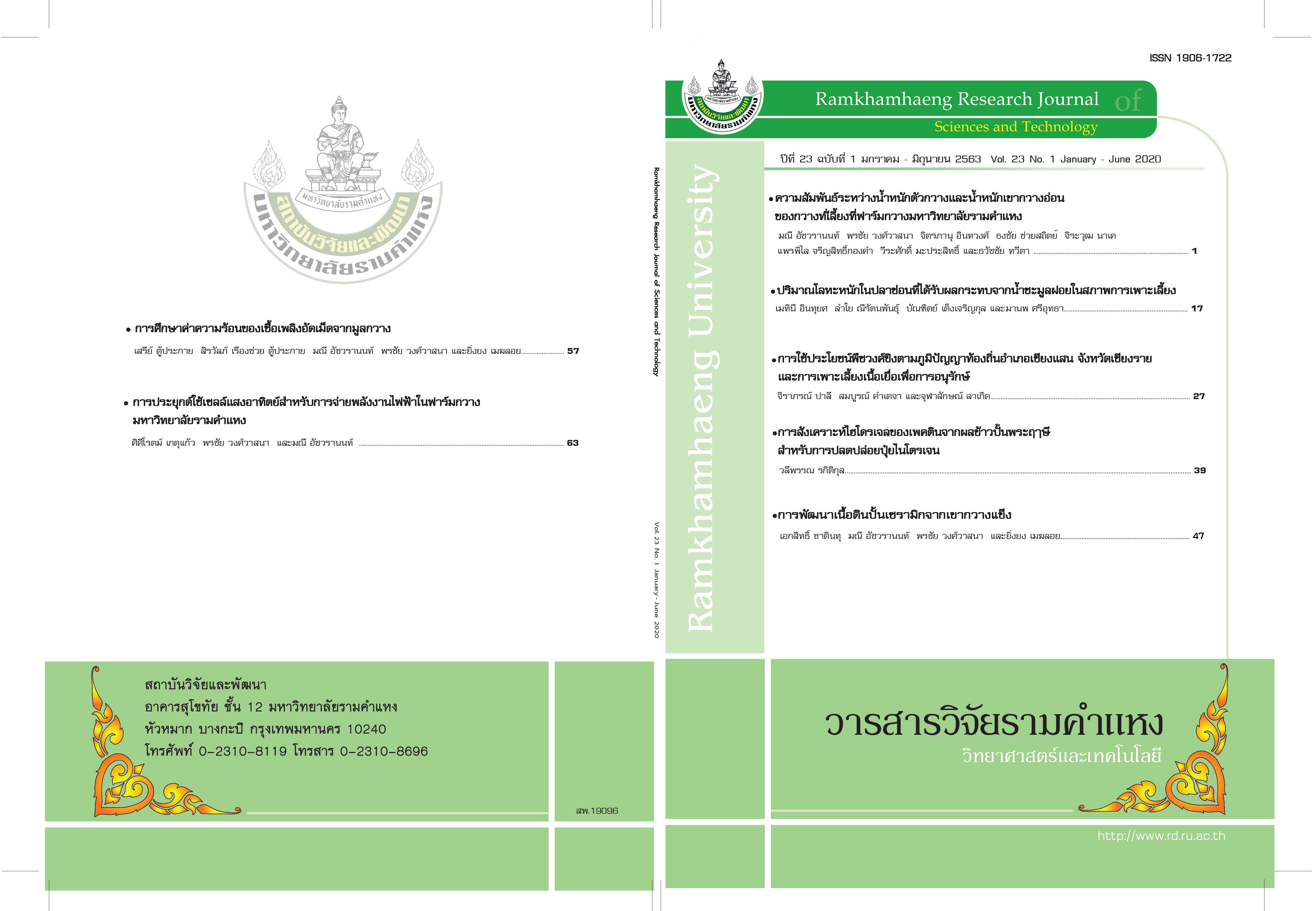Heavy Metal Concentration in Snakehead Fish (Channa striata) Affected by Landfill Leachate in Aquaculture
Main Article Content
Abstract
In this study, the researchers analyze the water quality i.e. temperature, potential of hydroyenion (pH), dissolved oxygen (DO), biochemical oxygen demand (BOD), electrical conductivity (EC), and concentrations of nine heavy metals i.e. arsenic (As), lead (Pb), cadmium (Cd), chromium (Cr), copper (Cu), steel (Fe), manganese (Mn), nickel (M), and zinc (Zn) in water, sediments, and Channa striata in the reservoir affected by landfill leachate from Khon Kaen City Municipality. Six samples of water and sediments were collected as well as five samples of C. striata bred in floating baskets for three months. The heavy metal concentrations were analyzed using inductively coupled plasma optical emission spectrometry (ICP-OES). The study of the water quality showed that all the parameters were at the standard level of surface water source type 3. The quantities of Cd, Cr, Cu, Fe, Mn, Ni, Pb, and Zn in the water as well as in the sediments did not exceed the standards. However, As exceeded the standards in the water and in the sediments. The heavy metal concentrations in C. striata did not exceed the standards for food
with contaminants.
Article Details
Ramkhamhaeng University
References
กรมส่งเสริมคุณภาพสิ่งแวดล้อม. 2554. การจัดการขยะมูลฝอยโดยชุมชน. กรุงเทพฯ. กรมส่งเสริมคุณภาพสิ่งแวดล้อมกระทรวงทรัพยากรธรรมชาติและสิ่งแวดล้อม.
เทศบาลนครขอนแก่น. 2560. ข้อมูลด้านสิ่งแวดล้อม. ที่มา http://www.kkmuni.go.th. 7 กุมภาพันธ์ 2562
พิมลพร พรมสิทธิ์. 2557. การประเมินความผิดปกติของโครโมโซมปลาช่อนในแหล่งน้ำที่ได้รับผลกระทบจากน้ำชะมูลฝอย. วิทยานิพนธ์ปริญญาวิทยาศาสตรมหาบัณฑิต. สาขาวิชาวิทยาศาสตร์สิ่งแวดล้อม. บัณฑิตวิทยาลัยมหาวิทยาลัยขอนแก่น.
รุ่งกิจ บูรณ์เจริญ. 2554. การจัดการขยะฐานศูนย์: กรณีศึกษาโรงเรียนจอมพระประชาสรรค์ อำเภอจอมพระ จังหวัดสุรินทร์. วิทยานิพนธ์วิทยาศาสตรมหาบัณฑิต. สาขาวิชาการจัดการสิ่งแวดล้อม. บัณฑิตวิทยาลัย. สถาบันบัณฑิตพัฒนบริหารศาสตร์.
อุไรวรรณ ภูนาพลอย. 2559. การประเมินความผิดปกติของโครโมโซมกบหนอง (Fejervarya limnocharis) ที่ได้รับผลกระทบจากน้ำชะมูลฝอย. วิทยานิพนธ์วิทยาศาสตรมหาบัณฑิต. สาขาวิชาวิทยาศาสตร์สิ่งแวดล้อม.มหาวิทยาลัยขอนแก่น.
Abbrazzini, T.F., Silva, C.A, Aparecida de Andrade D, Japiassú de Oliveira and Carneiro, W. 2014. Influence of digestion methods on the recovery of iron, zinc, nickel, chromium, cadmium and lead contents in 11 organic residues. Revista Brasileira de Ciência do Solo. 38(1): 166-176.
Ameur, W.B., El Megdiche, Y., de Lapuente, J., Barhoumi, B., Trabelsi, S., Ennaceur, S. et al. 2015. Oxidative stress, genotoxicity and histopathology biomarker responses in Mugil cephalus and Dicentrarchus labrax gill exposed to persistent pollutants. A field study in the Bizerte Lagoon: Tunisia. Chemosphere.135: 67-74.
Asaolu, S.S. and Olaofe, O. 2005. Biomagnification’s of some heavy and essential metals in sediment, fishes and crayfish from Ondo State Coastal Region, Nigeria. Pakistan Journal of Scientific and Industrial Research. 48(2): 96-102.
Ashraf, W. 2005. Accumulation of heavy metals in kidney and heart tissues of Epinephelus microdon fish from the Arabian Gulf. Environmental Monitoring and Assessment. 101(1): 311-316.
Biswas, A.K., Kumar, S., Babu, S.S., Bhattacharya, J.K. and Chakrabarti, T. 2010. Studies on environmental quality in and around municipal solid waste dumpsite. Resources Conservation and Recycling. 55:129-134.
Blaber, S.J.M. 2000. Tropical Estuarine Fishes: Ecology, Exploitation and Conservation. 1st ed. Blackwell Science. Oxford.
Brewer, G.J. 2010. Copper toxicity in the general population. Clinical neurophysiology. 121(4): 459-460. DOI: 10.1016/j.clinph.2009.12.015
Chand V. and Prasad S. 2013. ICP-OES assessment of heavy metal contamination
in tropical marine soils: a comparative study of two digestion techniques. Microchem Journal. 111: 53-61
Chain, E.S.K. and DeWalle, F. B. 1976. Sanitary landfill leachates and their treatments. Journal of the Environmental Engineering Division. ASCE. 102 (2): 411-431.
Farkas, A., Salanki, J., and Specziar, A. 2002. Relation between growth and the heavy metal concentration in organs of bream Abramis brama L. populating Lake Balaton. Archives of Environmental Contamination and Toxicology. 43(2): 236-243.
Farombi, E.O., Adelowo, O.A. and Ajimoko, Y.R. 2007. Biomarkers of oxidative stress and heavy metal levels as indicators of environmental pollution in African Cat fish (Clariasgariepinus) from Nigeria ogunriver. International Journal of Environmental Research and Public Health. 4(2): 158-165.
Hashim, R., Song, T., Muslim, N. and Yen, T. 2014. Determination of heavy metal levels in fishes from lower reach of the Kelantan river, Kelantan, Malaysia. Tropical Life Sciences Research. 25(2): 21-39
He, P.J., Xue, J.F., Shao, L.M., Lia, G.J. and Lee, D.J. 2006. Dissolved organic matter (DOM) in recycled leachate of bioreactor landfill. Water Research. 40(7): 1465-1473.
Lumb, A., Halliwell, D., Sharma, T. 2006. Application
of water quality index to monitor water quality: a case of the Mackenzie river basin, Canada. Environmental Monitoring and Assessment. 113: 411-429. DOI: 10.1007
/s10661-005-9092-6.
Nannoni, F., Mazzeo, R., Protano, B.G. and Santolini, R. 2015. Bioaccumulation of heavy elements by Armadillidium vulgare (Crustacea, Isopoda) exposed to fallout of a municipal solid waste landfill. Ecological Indicators. 49: 24-31.
OECD. 2009. Subchronic Inhalation Toxicity: 90-Day Study. Test Guideline No. 413. OECD Guidelines for the Testing of Chemicals. 1st ed. OECD: Paris.
Olowu, R.A., Ayejuyo, O.O., Adewuji, G.O., Adejoro, I.A., Denloye, A.A.B., Babatunde, A. O. et al. 2010. Determination of heavy metals in fish tissues, water and sediment from Epe and Badagry Lagoons,Lagos, Nigeria. E-Journal of Chemistry. 7(1): 215-221.
Roehrich, A.M. 2016. ICP guide: ICP-OES detection limits. ICP Traning_000.pdf, (pp. 5). Available online at:www.perkinelmer.com/atomicspectroscopy
U.S. Environmental Protection Agency (USEPA). 1996. Acid Digestion of Sediment, Sludges and Solids: 3050 method B Washington, D.C. USEPA
Vrhovac, V.G., Orešc, V., Gajski, G., Geric, G., Ruk, D. and Kollar, R. et al. 2013. Toxicological characterization of the landfill leachate prior/after chemical and electrochemical treatment: A study on human and plant cells. Chemosphere. 93: 939-945.
Wang, C., Liu, S., Zhao, Q., Deng, L. and Dong, S. 2012. Spatial variation and contamination assessment of heavy metals in sediments in the Manwan Reservoir, Lancang River. Ecotoxicology and Environmental Safety. 82: 32-39.
Yang, L., Li, Y., Xj, G., Ma, X., and yan, Q., 2013. Comparison of dry ashing, wet ashing and microwave digestion for determination of trace elements in Periostracum serpentis and Periostracum cicadae by ICP-AES. Journal of the Chilean Chemical Society. 58: 1876-1879. http://dx.doi.org/10.4067/S0717-9707201300030


